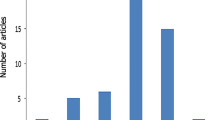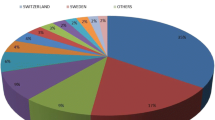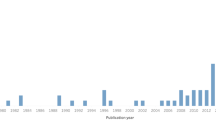Abstract
Bibliometric analyses may indicate the most active journals, authors, countries, institutions and specialties by evaluating the most cited articles in a given research field. To the authors’ knowledge, there is no bibliometric analysis regarding neurocritical care research. Thus, the aim of this study is to analyze and to provide a scope of the current scientific production in this area. The 100 most cited articles in the neurocritical care research were retrieved from the research “(neurocritical) AND (care)” in the Scopus database. The variables collected and included in this analysis were: number of citations, article title, first author’s name, year and journal of publication and its impact factor (IF), specialty, affiliation and country of the corresponding author at the time of publication, and category of the article. Also, these variables were assessed for primary research only. The articles were published in 34 different journals from 1995 to 2017, with a mean citation number of 109.36, ranging from 44 to 540. Neurocritical Care (23 articles in top 100 and 2190 citations, IF = 3.163) and Critical Care Medicine (20 articles and 2896 citations in top 100, IF = 6.630) were the journals with the greatest number of articles and citations, respectively. Neurocritical Care also had the highest number of primary research papers (15 articles, accounting for 850 citations). Excepting one article from Asia (Singapore) and one from Oceania (Australia), all the other 98 papers were from North America (67) or Europe (31). United States was the country with most articles (60, 35 primary research) and citations (6115) among the top 100. Columbia University (11 articles, being 7 primary research, and 915 citations) was the institution with the highest number of articles and primary research articles in top 100, whereas University of Heidelberg (6 articles and 1220 citations) was the most cited institution. Neurology was the specialty with the greatest number of publications in top 100 and the most cited one (57 articles and 5983 citations). The first author with the greatest number of publications as well as primary research articles was A. I. Qureshi (5 articles, being 4 primary research, and 660 citations), while the most cited was K. H. Polderman (2 articles and 749 citations). Fifty-nine publications were primary and 41 secondary research. Among primary research, treatment/management was the most frequent and most cited topics (33 articles and 4172 citations). To the authors’ knowledge, this is the first bibliometric analysis regarding neurocritical care research. Our findings suggest that the neurocritical care research field is more prominent in North America and Europe, more frequently published in specific critical care journals and after 1994. The most discussed topic was related to treatment and/or management within neurocritical care.

Similar content being viewed by others
References
Wijdicks EF. The history of neurocritical care. Handb Clin Neurol. 2017;140:3–14.
Rincon F, Mayer SA. Neurocritical care: a distinct discipline? Curr Opin Crit Care. 2007;13(2):115–21.
Samuels O, Webb A, Culler S, Martin K, Barrow D. Impact of a dedicated neurocritical care team in treating patients with aneurysmal subarachnoid hemorrhage. Neurocrit Care. 2011;14(3):334–40.
Suarez JI, Zaidat OO, Suri MF, et al. Length of stay and mortality in neurocritically ill patients: impact of a specialized neurocritical care team. Crit Care Med. 2004;32(11):2311–7.
Bershad EM, Feen ES, Hernandez OH, Suri MF, Suarez JI. Impact of a specialized neurointensive care team on outcomes of critically ill acute ischemic stroke patients. Neurocrit Care. 2008;9(3):287–92.
Jeong JH, Bang J, Jeong W, et al. A dedicated neurological intensive care unit offers improved outcomes for patients with brain and spine injuries. J Intensive Care Med. 2017;34(2):104–8.
Sarpong Y, Nattanmai P, Schelp G, et al. Improvement in quality metrics outcomes and patient and family satisfaction in a neurosciences intensive care unit after creation of a dedicated neurocritical care team. Crit Care Res Pract. 2017;2017:6394105.
Garner RM, Hirsch JA, Albuquerque FC, Fargen KM. Bibliometric indices: defining academic productivity and citation rates of researchers, departments and journals. J Neurointerv Surg. 2018;10(2):102–6.
Bohl MA, Ponce FA. Assessing the relevancy of highly cited works in neurosurgery. Part I: the 100 most relevant papers in neurosurgical journals. World Neurosurg. 2017;104:927–38.
Rosenberg AL, Tripathi RS, Blum J. The most influential articles in critical care medicine. J Crit Care. 2010;25(1):157–70.
Tripathi RS, Blum JM, Papadimos TJ, Rosenberg AL. A bibliometric search of citation classics in anesthesiology. BMC Anesthesiol. 2011;11:24.
Pagni M, Khan NR, Cohen HL, Choudhri AF. Highly cited works in radiology: the top 100 cited articles in radiologic journals. Acad Radiol. 2014;21(8):1056–66.
Bohl MA, Turner JD, Little AS, Nakaji P, Ponce FA. Assessing the relevancy of “citation classics” in neurosurgery. Part II: foundational papers in neurosurgery. World Neurosurg. 2017;104:939–66.
Ollerton JE, Sugrue M. Citation classics in trauma. J Trauma Acute Care Surg. 2005;58(2):364–9.
Alotaibi NM, Nassiri F, Badhiwala JH, et al. The most cited works in aneurysmal subarachnoid hemorrhage: a bibliometric analysis of the 100 most cited articles. World Neurosurg. 2016;89(587–92):e6.
Li L, Ma X, Pandey S, et al. The most-cited works in severe traumatic brain injury: a bibliometric analysis of the 100 most-cited articles. World Neurosurg. 2018;113:e82–7.
Badhiwala JH, Nassiri F, Witiw CD, et al. Highly cited works in spinal disorders: the top 100 most cited papers published in spine journals. Spine (Phila Pa 1976). 2018;43(24):1746–55.
Xue JH, Hu ZP, Lai P, Cai DQ, Wen ES. The 100 most-cited articles in Parkinson’s disease. Neurol Sci. 2018;39(9):1537–45.
Park KM, Kim SE, Lee BI, et al. Top 100 cited articles on epilepsy and status epilepticus: a bibliometric analysis. J Clin Neurosci. 2017;42:12–8.
Brophy GM, Bell R, Claassen J, et al. Guidelines for the evaluation and management of status epilepticus. Neurocrit Care. 2012;17(1):3–23.
Ding H, Song X, Chen L, Zheng X, Jiang G. The 100 most-cited papers in general thoracic surgery: a bibliography analysis. Int J Surg. 2018;53:230–8.
Dokur M, Uysal E. Top 100 cited articles in traumatology: a bibliometric analysis. Ulus Travma Acil Cerrahi Derg. 2018;24(4):294–302.
Seglen PO. Citation rates and journal impact factors are not suitable for evaluation of research. Acta Orthop Scand. 1998;69(3):224–9.
Masic I, Begic E. Scientometric dilemma: is H-index adequate for scientific validity of academic’s work? Acta Inform Med. 2016;24(4):228–32.
Yaminfirooz M, Ardali FR. Identifying the factors affecting papers’ citability in the field of medicine: an evidence-based approach using 200 highly and lowly-cited papers. Acta Inform Med. 2018;26(1):10–4.
Falagas ME, Pitsouni EI, Malietzis GA, Pappas G. Comparison of PubMed, Scopus, Web of Science, and Google Scholar: strengths and weaknesses. FASEB J. 2008;22(2):338–42.
Martín-Martín A, Orduna-Malea E, Thelwall M, López-Cózar ED. Google Scholar, Web of Science, and Scopus: a systematic comparison of citations in 252 subject categories. J Informetr. 2018;12(4):1160–77.
Author information
Authors and Affiliations
Contributions
MBR—Data Collection, Data Analysis, Manuscript writing; EK—Data Analysis, Manuscript writing; JRJ—Data Analysis, Manuscript writing; MJT—Project development, Data Analysis; EGF—Project development, Data Analysis, Manuscript writing.
Corresponding author
Ethics declarations
Source of support
None.
Conflict of interest
The authors declare that they have no conflict of interest.
Ethical Approval/Informed Consent
This article does not contain any studies with human participants or animals performed by any of the authors.
Additional information
Publisher's Note
Springer Nature remains neutral with regard to jurisdictional claims in published maps and institutional affiliations.
Rights and permissions
About this article
Cite this article
Ramos, M.B., Koterba, E., Rosi Júnior, J. et al. A Bibliometric Analysis of the Most Cited Articles in Neurocritical Care Research. Neurocrit Care 31, 365–372 (2019). https://doi.org/10.1007/s12028-019-00731-6
Published:
Issue Date:
DOI: https://doi.org/10.1007/s12028-019-00731-6




